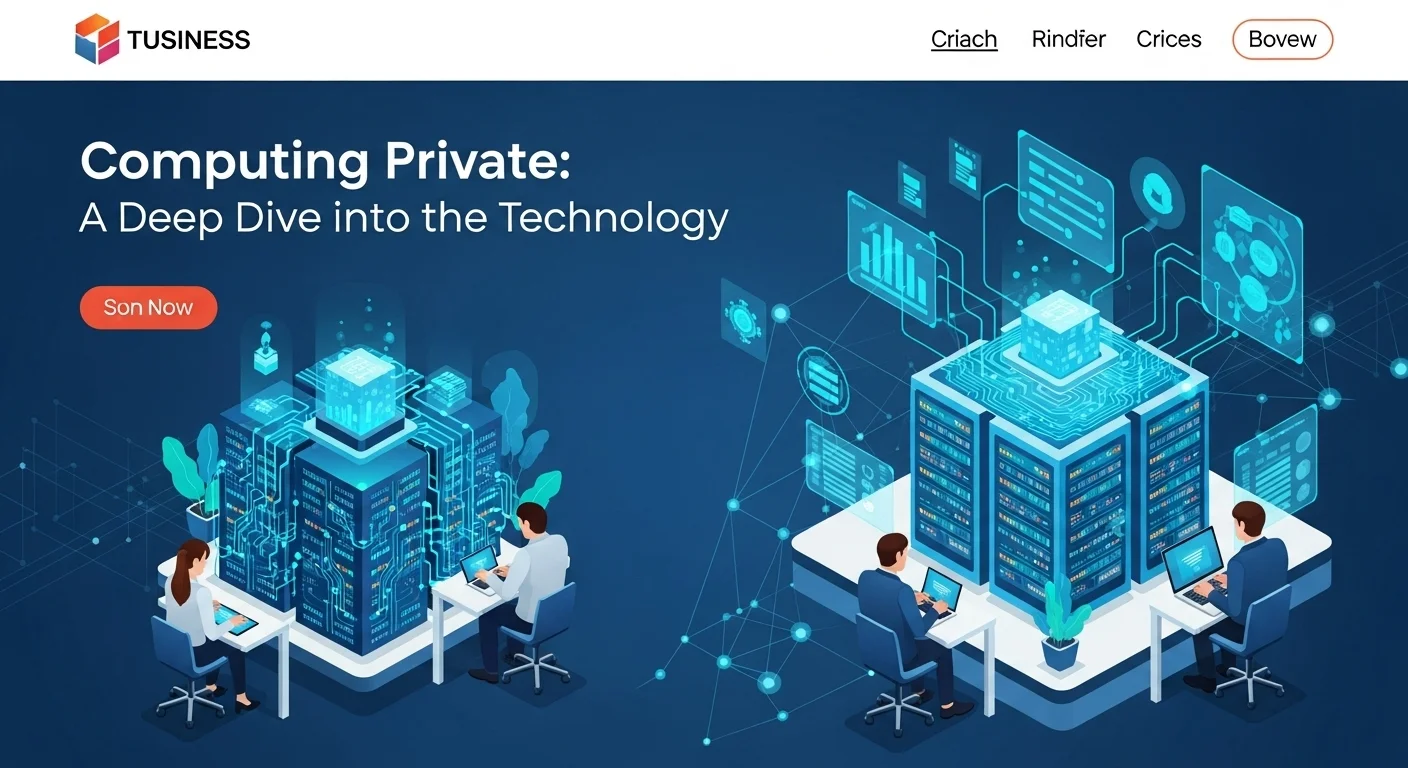Private Cloud Computing: Your Personal Guide to Security, Control, and Real-World Solutions

Executive Summary
I've spent years helping businesses navigate the complex world of cloud technology. In an age of data breaches and strict regulations, many are rediscovering a powerful strategy: the private cloud. It's not just about having your own hardware; it's about taking back control. This is more than a technical trend; it's a move toward building a secure, efficient, and customized digital foundation. Forget the confusing jargon. I'm here to break down what private cloud really means, how it differs from a VPC, and how solutions from providers like Microsoft can give your business the competitive edge it needs. Let’s dive in.
Table of Contents
Table of Contents
What Exactly is a Private Cloud? And Why Should You Care?
I've been in the IT world for over two decades, and I've seen terms come and go. 'Private Cloud' is one that's stuck around—and for a very good reason. At its heart, a private cloud is an environment built exclusively for your organization. Think of the public cloud as a giant apartment building where you rent a unit. You share hallways, plumbing, and the foundation with hundreds of other tenants. A private cloud, on the other hand, is your own custom-built single-family home. The entire infrastructure is yours and yours alone.
This single-tenant distinction is the secret sauce. It gives you a level of control and security that a shared public cloud just can't offer. And in today's world, you simply can't ignore this. With data privacy laws like GDPR in Europe and HIPAA for healthcare in the U.S., businesses are under immense pressure to protect sensitive information. Having a dedicated environment allows you to build a fortress around your data, with custom security measures tailored specifically to your needs, from the physical servers right up to your applications. You set the rules, not the cloud provider.
The Nitty-Gritty: How Private Cloud Works
So how does this magic happen? The foundation is a technology called virtualization. In simple terms, virtualization software acts as a smart layer on top of your physical hardware (your servers, storage, and networking). It pools all those physical resources together and lets you digitally slice them up into many smaller, independent virtual computers or 'VMs'. On top of this, a cloud management platform gives you that 'cloud' experience: a self-service portal where your teams can spin up new servers and services on demand, just like in the public cloud, but all within your own private, secure playground.
When I talk with clients, we usually discuss three main ways to set this up:
- On-Premises Private Cloud: You own and manage everything in your own data center. This gives you maximum control but requires a significant upfront investment and a skilled IT team to run it.
- Hosted Private Cloud: A third party owns and hosts the hardware for you, but it's still dedicated entirely to your business. You get the privacy without the headache of managing physical machines.
- Managed Private Cloud: This takes it a step further. A provider hosts and manages the entire environment for you, including the software and applications. It's a great option if you want the security of a private cloud but don't have a large internal IT department.
Now, here’s a point of confusion I see all the time: the difference between a private cloud and a Virtual Private Cloud (VPC). A VPC is essentially a cordoned-off section *within* a public cloud. It gives you a private network, but the underlying hardware is still shared with other customers. It's like having a VIP room in a public nightclub—it's more private, but you're still in the same building. A true private cloud is your own exclusive venue.
Business Applications and Strategic Benefits
The move to a private cloud is almost always driven by real-world business needs. I've worked with financial firms that need to lock down customer data, healthcare organizations that must protect patient records under HIPAA, and manufacturing giants that want to safeguard their valuable research and development secrets. They all turn to private clouds for peace of mind and performance.
- Rock-Solid Performance: You've probably heard of the 'noisy neighbor' problem in public clouds, where another user's heavy workload can slow you down. In a private cloud, that problem disappears. Your resources are your resources, leading to predictable, consistent performance for your most important applications.
- Total Control and Customization: You get to pick the exact hardware and software that's perfect for your applications. This means you can fine-tune the environment for maximum performance and efficiency, something you can't do in a standardized public cloud.
- Predictable Costs Over Time: While the initial setup cost can be higher, for stable and predictable workloads, a private cloud can actually be more cost-effective in the long run than the pay-as-you-go public cloud model. You're not paying a premium for scalability you might not need.
- The Perfect Hybrid Foundation: A private cloud is the ideal home base for a hybrid cloud strategy. You can keep your most sensitive data and stable applications on your private cloud while using the public cloud for things like development, testing, or handling unexpected traffic spikes. It’s truly the best of both worlds.
The market has some heavy hitters, from Dell and VMware to the big public cloud providers themselves. For instance, Microsoft's private cloud computing solution, Azure Stack, is designed to bring the Azure public cloud experience right into your own data center. This allows you to build and manage applications in the same way, whether they're on your private infrastructure or in the public cloud, making a hybrid strategy much simpler to execute. This ability to create a secure, high-performance foundation is why private cloud technology remains so critical for any modern business.

Your Blueprint for Building and Choosing a Private Cloud
Alright, so you're sold on the idea of a private cloud. But where do you actually start? Let's be clear: this is a major strategic project, not a weekend DIY task. Successfully implementing a private cloud computing environment requires careful planning across technology, finance, and operations. Let's walk through the blueprint.
Technical Deep Dive: Architecting Your Private Cloud
Building your own private cloud means assembling a stack of hardware and software that works in perfect harmony. Here's what I always tell my clients to focus on.
1. The Hardware Foundation:
- Compute (The Engine): These are your servers, the workhorses that provide the processing power. You'll want to think about the kinds of applications you'll be running to choose the right mix of CPU and RAM.
- Storage (The Vault): This is where your company's crown jewels—your data—will live. You'll look at things like Storage Area Networks (SANs) for high-speed database access or Network-Attached Storage (NAS) for general files. The modern approach is software-defined storage (SDS), which gives you incredible flexibility.
- Networking (The Nervous System): This is the high-speed fabric that connects everything. Switches, routers, and load balancers are key. A critical security practice here is network segmentation—creating isolated zones to stop any potential threats from spreading across your environment.
2. The Software Brains:
- Hypervisor (The Virtualization Magic): This is the software that creates virtual machines (VMs). It's what allows you to run many different 'guest' operating systems on a single physical server. The big names here are VMware vSphere, Microsoft Hyper-V, and the open-source KVM.
- Cloud Management Platform (The Control Panel): This is the orchestration engine that makes it all feel like a 'cloud'. It provides the self-service portal for your users, automates tasks, and tracks usage. Think of tools like VMware's vRealize Suite, Microsoft System Center, or the incredibly powerful (and complex) open-source platform, OpenStack.
- Automation Tools (The Robots): To achieve true efficiency, you'll use tools like Ansible, Puppet, or Chef. They help you automate server configuration and application deployments, turning your infrastructure management into code.
A Comparative Analysis of Private Cloud Computing Providers
Choosing the right partner is just as important as choosing the right tech. The market for private cloud computing providers is crowded, but they generally fall into a few categories:
- The Classic Builders (Hardware & Software Vendors): These are the companies that give you the Lego bricks to build your own cloud. VMware is a giant in this space with its comprehensive software stack. Dell Technologies and HPE offer pre-packaged hardware solutions (hyper-converged infrastructure) that simplify deployment. And IBM/Red Hat is a huge proponent of using its OpenShift platform to build container-based private clouds.
- The Hybrid Experts (Public Cloud Providers): The big cloud players know that not everyone is moving 100% to the public cloud. So, they've created solutions to bring their cloud experience to you.
- Microsoft private cloud computing: Microsoft's Azure Stack portfolio is a brilliant example. Azure Stack Hub lets you run Azure services completely on-premises. More commonly, I see clients using Azure Stack HCI, a solution that modernizes your on-premise servers but integrates them directly with Azure for management and security via Azure Arc. It's a fantastic way to get a consistent hybrid experience.
- AWS Outposts: Amazon will literally ship you a rack of their own hardware and manage it for you in your data center. You get the same AWS experience, just on your turf.
- Google Anthos: This is Google's platform for managing applications consistently across your own data center and Google's cloud, built on the power of Kubernetes.
Virtual Private Cloud (VPC) vs. True Private Cloud: A Critical Distinction
I'm bringing this up again because it's that important. Getting this wrong can lead to costly mistakes in your security strategy. Here's a simple breakdown:
| Feature | True Private Cloud | Virtual Private Cloud (VPC) |
|---|---|---|
| Infrastructure | Dedicated physical hardware just for you. | A logically private slice of a shared public cloud. |
| Isolation | Physical separation. Your gear is your gear. | Logical separation through networking rules. |
| Control | You control everything, from the hardware up. | You control the virtual network, but not the physical gear. |
| Security | The highest level of security and privacy possible. | Very secure, but you're still relying on the public provider's underlying security. |
| Cost Model | Higher upfront cost (CapEx), but can be cheaper long-term. | Pay-as-you-go, operational cost (OpEx). |
| Best For | Regulated industries, critical apps, high-performance needs. | Extending your network to the cloud, securing web apps. |
The bottom line is this: a VPC is like having a private security detail in a public space, while a private cloud is your own secure, private fortress.
Business Techniques for Private Cloud Adoption
This is a business decision, so let's talk business strategy.
1. Don't Just Look at the Sticker Price: You must do a full Total Cost of Ownership (TCO) analysis. For a private cloud, that means including the cost of hardware, software, power, cooling, and staff time. Compare that to the projected public cloud costs over at least three to five years. For stable workloads, you might be surprised how often the private cloud comes out ahead.
2. Have a Smart Moving Plan: Don't try to move everything at once. Categorize your applications. Some are easy 'lift-and-shift' candidates. Others might need to be modernized first. Some you'll leave where they are for now, and some you might just decide to retire. A phased approach is always less risky.
3. Govern Your Cloud: A private cloud can become a messy, expensive free-for-all if you don't set rules. Create a clear governance model. Who can deploy new resources? How do you track costs and charge them back to the right departments? A solid operating model ensures your private cloud in cloud computing remains a valuable, well-managed asset, not a hidden cost center.

Pro Tips for Mastering Your Private Cloud
Once your private cloud computing environment is up and running, the journey isn't over—in many ways, it's just beginning. A private cloud is a high-performance asset, and like any valuable tool, it needs ongoing care and strategic thinking to deliver its full potential. Here are some of the most important tips and strategies I share with my clients to help them get the most out of their investment.
Best Practices for Day-to-Day Management
A well-managed private cloud is efficient and secure. Letting things slide can lead to performance issues, security holes, and wasted money.
1. Embrace a 'Zero-Trust' Security Mindset: Let's get one thing straight: the old 'castle-and-moat' idea of security is dead. A Zero-Trust model assumes that threats are already inside your network. The motto is 'never trust, always verify.' Every single user and device has to prove who they are before they can access anything. Key actions include:
- Micro-segmentation: This is a game-changer. Instead of just having a perimeter firewall, you create tiny, isolated security zones around individual workloads. If one area is breached, the damage is contained and can't spread.
- Strict Identity and Access Management (IAM): Implement the Principle of Least Privilege. This means users get the absolute minimum access they need to do their jobs, and nothing more. Always, always enforce Multi-Factor Authentication (MFA).
- Constant Vigilance: You have to be proactive. Run regular security audits and hire ethical hackers for penetration testing to find weaknesses before the bad guys do.
2. Be Obsessive About Performance and Capacity: One of the main reasons you chose a private cloud was for predictable performance. To keep it that way, you need to monitor everything: CPU, memory, storage speed, and network traffic. Use this data to plan for the future. Don't wait for things to slow down before you add more capacity. Good tools can even use analytics to predict when you'll need to upgrade, keeping you ahead of the curve.
3. Have a Bulletproof Backup and Disaster Recovery (DR) Plan: I can't stress this enough. A private cloud isn't invincible. It's still vulnerable to hardware failure, power outages, and cyberattacks like ransomware. Your DR plan is non-negotiable.
- Follow the 3-2-1 rule: Keep at least three copies of your data, on two different types of media, with one copy stored safely off-site.
- Test your plan! A DR plan that has never been tested is not a plan; it's a prayer. You need to know for a fact that you can restore your services within your target timeframes.
My Go-To Toolkit for Private Cloud
You can't manage a complex private cloud in cloud computing environment with just a spreadsheet. You need the right tools for the job.
- Monitoring Tools: Solutions like Datadog, Dynatrace, or Nagios are like an EKG for your cloud. They give you deep visibility into the health of your entire stack and alert you when something's wrong.
- Security Tools: A Security Information and Event Management (SIEM) system like Splunk is essential. It collects log data from all over your network and uses AI to spot suspicious activity.
- Cost Management Tools: To avoid 'cloud sprawl,' you need tools that can track which departments are using which resources. This 'showback' or 'chargeback' capability drives accountability and efficiency. VMware's vRealize Operations is a strong player here.
The Strategic Future: Thinking Hybrid
In today's world, your private cloud shouldn't be an island. The smartest companies I work with treat it as their secure home base in a larger hybrid or multi-cloud strategy. The future lies in how seamlessly you can integrate it with public cloud services. This is where solutions from private cloud computing providers that are built for hybrid really excel.
For example, using a Microsoft private cloud computing solution like Azure Arc is a game-changer. It extends Azure's management tools to your on-premises private cloud. This means you can use the same Azure portal and the same scripts to manage your private servers and your public cloud resources. It gives you that 'single pane of glass' to see and control everything, which dramatically simplifies operations.
Finally, always be evaluating. The application that needs the security of your private cloud today might be perfect for the public cloud tomorrow. A winning hybrid strategy means having the flexibility and the processes in place to move workloads where they make the most sense for the business. That agility is the ultimate goal.
Expert Reviews & Testimonials
Sarah Johnson, Business Owner ⭐⭐⭐
The information about private cloud is solid, but as a business owner, I'd have loved to see a few more direct case studies or practical examples for small to medium-sized businesses.
Mike Chen, IT Consultant ⭐⭐⭐⭐
A really useful article on private cloud. It helped me connect a lot of dots for a client project. Some of the deeper technical concepts could be simplified a bit further, but it's a great overview.
Emma Davis, Tech Expert ⭐⭐⭐⭐⭐
Absolutely excellent! As a tech professional specializing in cloud infrastructure, I found this to be comprehensive and spot-on. It clarified key differences, like with VPCs, perfectly. A great resource.



